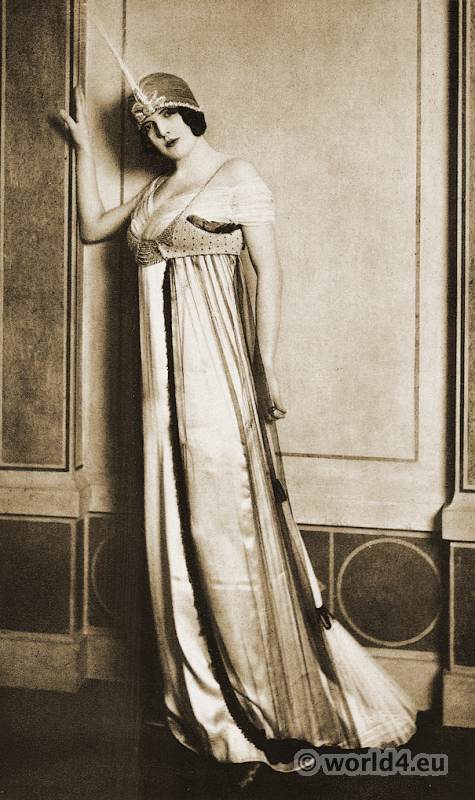
EMPIRE-ROMANTIC. 1800-1840.
PLATE NO. 89
Formal evening wear. Party dress around 1810.
The narrow, cylindrical, Neo-Classic dress as portrayed on the figures of Plates 85, 87, and 96 could not long withstand the urge for elaboration and display to show wealth. The result of this change, which came after 1810, is shown on these two figures. An examination of the plates of this set will show that the headdress has become elaborate, the general simplicity of material and design has vanished, and, most significant, the skirts have begun to widen at the hem. Both of these costumes are formal evening ensembles: that on the left more sedate and matronly, the other a dancing dress.
The coiffure was showing signs of returning to that style so prevalent before the start of the French Revolution. The figure on the left has a reasonably simple coiffure worn beneath the very characteristic turban. These had always been in use as a man’s lounging accessory, but Napoleon’s Egyptian campaign caused women to take readily to its use. Needless to say, they became highly stylized and unturban like in much of their decoration. A more built-up and elaborate headdress appears on the other woman. Practically all semblance of the classic has left this and we look to the Louis XVI period for the inspiration of its silhouette.
The black or outermost garment with the short sleeves is a form of the pelisse. Other varieties of this outer garment worn during the period were less scanty and had long sleeves. Her outer dress is of a richer, heavier material. It has been drawn back on one side to expose the lighter, softer petticoat. This was probably accomplished by having it split down the left side and tucking the right corner underneath.
The party dress here shows definite leanings toward the Romantic period, which began with 1815. At this time waistlines wore still extremely high; and although the rest of the costume returned to the two-part silhouette, the waistline did not begin to return to normal until after 1820. This extremely short bodice with its shirred front and dagged sleeves decidedly followed the Romantic tendency to copy style items from Middle Age and Renaissance sources. The shirt is of fairly stiff material weighted down by the rouloux of padding at the hem. This idea found more expression later. Ball dresses were worn shorter. The large wreaths were a novelty of decoration. The Romantic era was an experimental one in decoration, and many novelties were often worn on late Empire creations.
The toes of the shoes were more pointed, and there was a tendency towards slightly raised heels.
Gloves and fans such as these were always worn at pretentious affairs.
History of Costume

Related
Discover more from World4 Costume Culture History
Subscribe to get the latest posts sent to your email.






